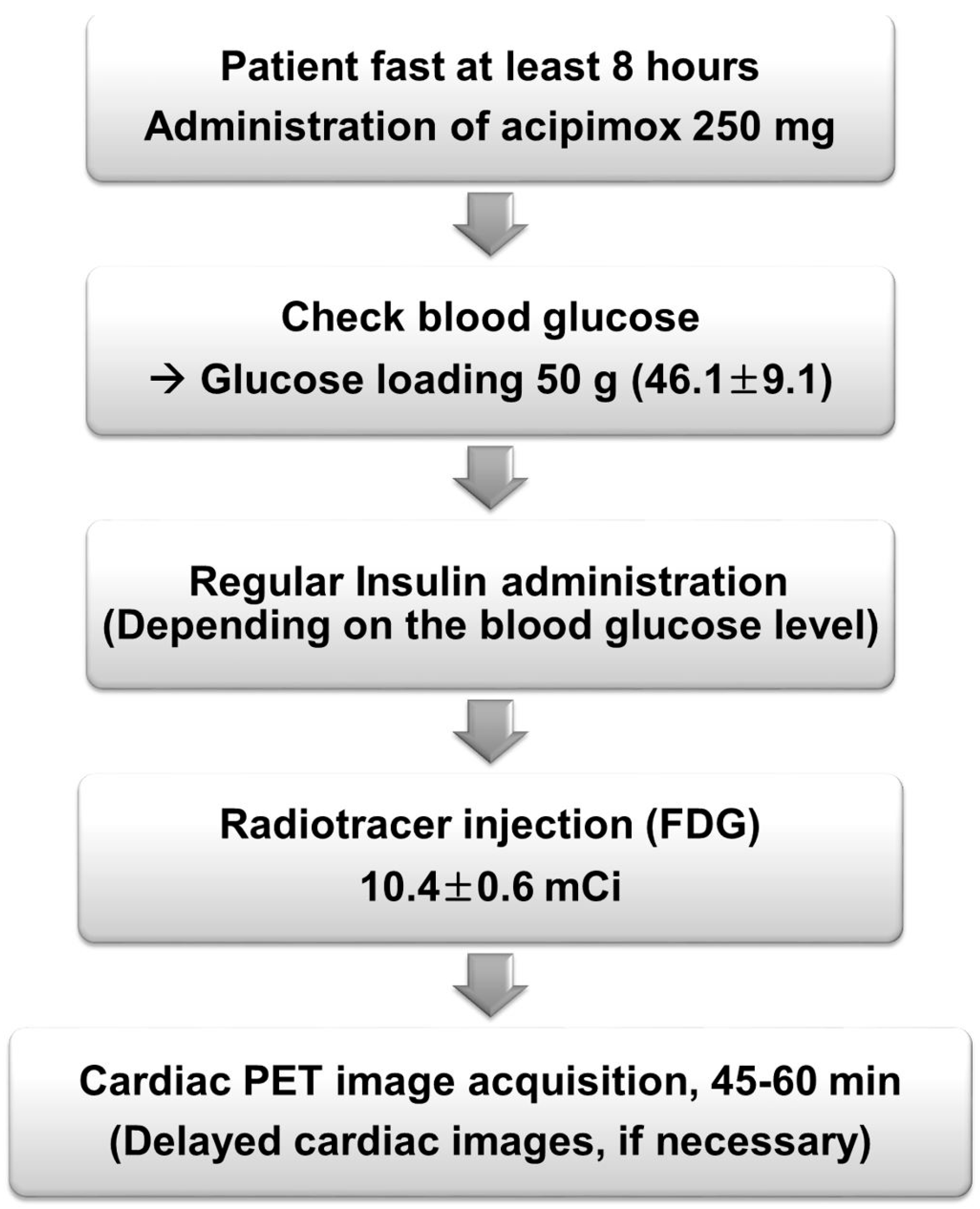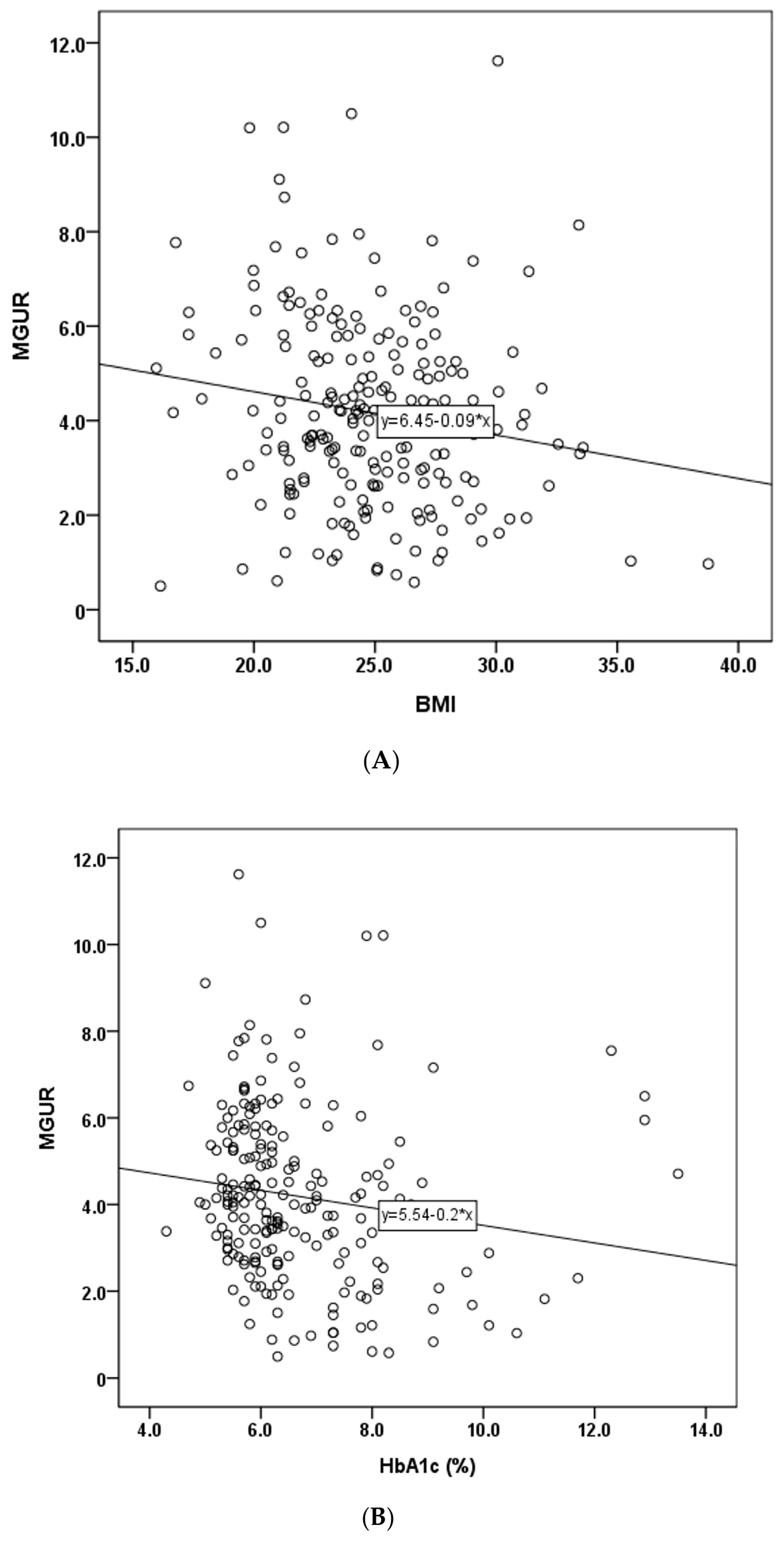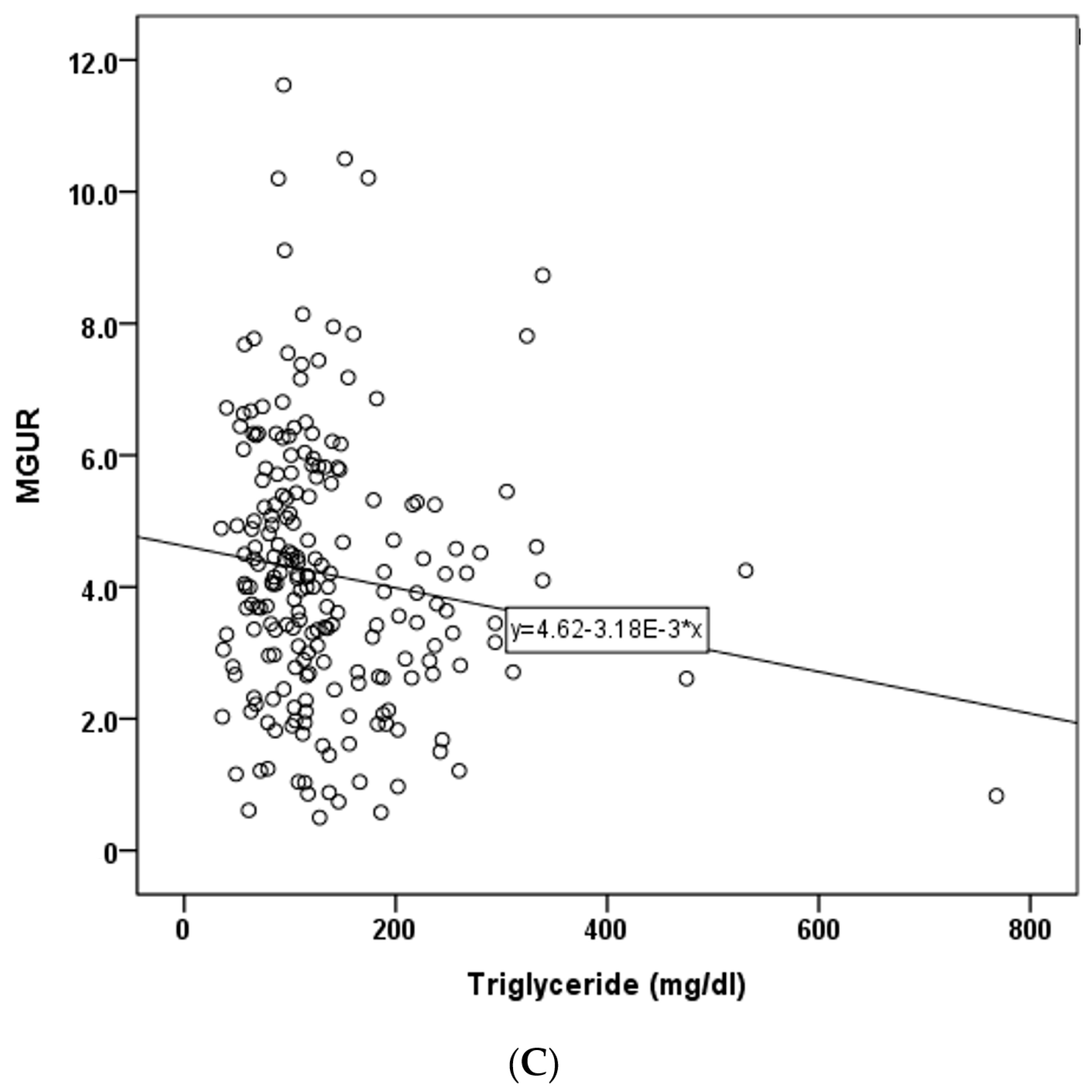Evaluation of Clinical Variables Affecting Myocardial Glucose Uptake in Cardiac FDG PET
Abstract
:1. Introduction
2. Materials and Methods
2.1. Subjects
2.2. Image Acquisition and Measurement
2.3. Data Analysis
3. Results
3.1. Patient Characteristics
3.2. Correlation Analysis with MGUR
3.3. Group Analysis According to BMI
4. Discussion
Supplementary Materials
Author Contributions
Funding
Institutional Review Board Statement
Informed Consent Statement
Data Availability Statement
Conflicts of Interest
References
- North, B.J.; Sinclair, D.A. The intersection between aging and cardiovascular disease. Circ. Res. 2012, 110, 1097–1108. [Google Scholar] [CrossRef] [PubMed]
- Khan, M.A.; Hashim, M.J.; Mustafa, H.; Baniyas, M.Y.; Al Suwaidi, S.; AlKatheeri, R.; Alblooshi, F.M.K.; Almatrooshi, M.; Alzaabi, M.E.H.; Al Darmaki, R.S.; et al. Global Epidemiology of Ischemic Heart Disease: Results from the Global Burden of Disease Study. Cureus 2020, 12, e9349. [Google Scholar] [CrossRef] [PubMed]
- Schinkel, A.F.; Bax, J.J.; Poldermans, D.; Elhendy, A.; Ferrari, R.; Rahimtoola, S.H. Hibernating myocardium: Diagnosis and patient outcomes. Curr. Probl. Cardiol. 2007, 32, 375–410. [Google Scholar] [CrossRef] [PubMed]
- Gerber, B.L.; Rousseau, M.F.; Ahn, S.A.; le Polain de Waroux, J.B.; Pouleur, A.C.; Phlips, T.; Vancraeynest, D.; Pasquet, A.; Vanoverschelde, J.L. Prognostic value of myocardial viability by delayed-enhanced magnetic resonance in patients with coronary artery disease and low ejection fraction: Impact of revascularization therapy. J. Am. Coll. Cardiol. 2012, 59, 825–835. [Google Scholar] [CrossRef] [PubMed]
- Allman, K.C.; Shaw, L.J.; Hachamovitch, R.; Udelson, J.E. Myocardial viability testing and impact of revascularization on prognosis in patients with coronary artery disease and left ventricular dysfunction: A meta-analysis. J. Am. Coll. Cardiol. 2002, 39, 1151–1158. [Google Scholar] [CrossRef] [PubMed]
- Rieves, D.; Jacobs, P. The Use of Published Clinical Study Reports to Support U.S. Food and Drug Administration Approval of Imaging Agents. J. Nucl. Med. 2016, 57, 2022–2026. [Google Scholar] [CrossRef] [PubMed]
- Abraham, A.; Nichol, G.; Williams, K.A.; Guo, A.; deKemp, R.A.; Garrard, L.; Davies, R.A.; Duchesne, L.; Haddad, H.; Chow, B.; et al. 18F-FDG PET imaging of myocardial viability in an experienced center with access to 18F-FDG and integration with clinical management teams: The Ottawa-FIVE substudy of the PARR 2 trial. J. Nucl. Med. 2010, 51, 567–574. [Google Scholar] [CrossRef] [PubMed]
- Ghesani, M.; Depuey, E.G.; Rozanski, A. Role of F-18 FDG positron emission tomography (PET) in the assessment of myocardial viability. Echocardiography 2005, 22, 165–177. [Google Scholar] [CrossRef] [PubMed]
- D’Egidio, G.; Nichol, G.; Williams, K.A.; Guo, A.; Garrard, L.; deKemp, R.; Ruddy, T.D.; DaSilva, J.; Humen, D.; Gulenchyn, K.Y.; et al. Increasing benefit from revascularization is associated with increasing amounts of myocardial hibernation: A substudy of the PARR-2 trial. JACC Cardiovasc. Imaging 2009, 2, 1060–1068. [Google Scholar] [CrossRef]
- Dilsizian, V.; Bacharach, S.L.; Beanlands, R.S.; Bergmann, S.R.; Delbeke, D.; Dorbala, S.; Gropler, R.J.; Knuuti, J.; Schelbert, H.R.; Travin, M.I. ASNC imaging guidelines/SNMMI procedure standard for positron emission tomography (PET) nuclear cardiology procedures. J. Nucl. Cardiol. 2016, 23, 1187–1226. [Google Scholar] [CrossRef]
- Hansen, A.K.; Gejl, M.; Bouchelouche, K.; Tolbod, L.P.; Gormsen, L.C. Reverse Mismatch Pattern in Cardiac 18F-FDG Viability PET/CT Is Not Associated With Poor Outcome of Revascularization: A Retrospective Outcome Study of 91 Patients With Heart Failure. Clin. Nucl. Med. 2016, 41, e428–e435. [Google Scholar] [CrossRef] [PubMed]
- Sandstede, J.J. Assessment of myocardial viability by MR imaging. Eur. Radiol. 2003, 13, 52–61. [Google Scholar] [CrossRef] [PubMed]
- Sandstede, J.J.; Lipke, C.; Beer, M.; Harre, K.; Pabst, T.; Kenn, W.; Neubauer, S.; Hahn, D. Analysis of first-pass and delayed contrast-enhancement patterns of dysfunctional myocardium on MR imaging: Use in the prediction of myocardial viability. AJR Am. J. Roentgenol. 2000, 174, 1737–1740. [Google Scholar] [CrossRef] [PubMed]
- Hunold, P.; Jakob, H.; Erbel, R.; Barkhausen, J.; Heilmaier, C. Accuracy of myocardial viability imaging by cardiac MRI and PET depending on left ventricular function. World J. Cardiol. 2018, 10, 110–118. [Google Scholar] [CrossRef] [PubMed]
- Kandolin, R.M.; Wiefels, C.C.; Mesquita, C.T.; Chong, A.Y.; Boland, P.; Glineur, D.; Sun, L.; Beanlands, R.S.; Mielniczuk, L.M. The Current Role of Viability Imaging to Guide Revascularization and Therapy Decisions in Patients With Heart Failure and Reduced Left Ventricular Function. Can. J. Cardiol. 2019, 35, 1015–1029. [Google Scholar] [CrossRef] [PubMed]
- Carrel, T.; Jenni, R.; Haubold-Reuter, S.; von Schulthess, G.; Pasic, M.; Turina, M. Improvement of severely reduced left ventricular function after surgical revascularization in patients with preoperative myocardial infarction. Eur. J. Cardio-Thorac. Surg. 1992, 6, 479–484. [Google Scholar] [CrossRef] [PubMed]
- Grandin, C.; Wijns, W.; Melin, J.A.; Bol, A.; Robert, A.R.; Heyndrickx, G.R.; Michel, C.; Vanoverschelde, J.L. Delineation of myocardial viability with PET. J. Nucl. Med. 1995, 36, 1543–1552. [Google Scholar]
- Tillisch, J.; Brunken, R.; Marshall, R.; Schwaiger, M.; Mandelkern, M.; Phelps, M.; Schelbert, H. Reversibility of cardiac wall-motion abnormalities predicted by positron tomography. N. Engl. J. Med. 1986, 314, 884–888. [Google Scholar] [CrossRef] [PubMed]
- Beanlands, R.S.; Nichol, G.; Huszti, E.; Humen, D.; Racine, N.; Freeman, M.; Gulenchyn, K.Y.; Garrard, L.; deKemp, R.; Guo, A.; et al. F-18-fluorodeoxyglucose positron emission tomography imaging-assisted management of patients with severe left ventricular dysfunction and suspected coronary disease: A randomized, controlled trial (PARR-2). J. Am. Coll. Cardiol. 2007, 50, 2002–2012. [Google Scholar] [CrossRef]
- McGill, J.B.; Peterson, L.R.; Herrero, P.; Saeed, I.M.; Recklein, C.; Coggan, A.R.; Demoss, A.J.; Schechtman, K.B.; Dence, C.S.; Gropler, R.J. Potentiation of abnormalities in myocardial metabolism with the development of diabetes in women with obesity and insulin resistance. J. Nucl. Cardiol. 2011, 18, 421–429; quiz 432–433. [Google Scholar] [CrossRef]
- Taegtmeyer, H.; Stanley, W.C. Too much or not enough of a good thing? Cardiac glucolipotoxicity versus lipoprotection. J. Mol. Cell. Cardiol. 2011, 50, 2–5. [Google Scholar] [CrossRef]
- Peterson, L.R.; Herrero, P.; Schechtman, K.B.; Racette, S.B.; Waggoner, A.D.; Kisrieva-Ware, Z.; Dence, C.; Klein, S.; Marsala, J.; Meyer, T.; et al. Effect of obesity and insulin resistance on myocardial substrate metabolism and efficiency in young women. Circulation 2004, 109, 2191–2196. [Google Scholar] [CrossRef] [PubMed]
- Peterson, L.R.; Soto, P.F.; Herrero, P.; Mohammed, B.S.; Avidan, M.S.; Schechtman, K.B.; Dence, C.; Gropler, R.J. Impact of gender on the myocardial metabolic response to obesity. JACC Cardiovasc. Imaging 2008, 1, 424–433. [Google Scholar] [CrossRef] [PubMed]
- Herrero, P.; Peterson, L.R.; McGill, J.B.; Matthew, S.; Lesniak, D.; Dence, C.; Gropler, R.J. Increased myocardial fatty acid metabolism in patients with type 1 diabetes mellitus. J. Am. Coll. Cardiol. 2006, 47, 598–604. [Google Scholar] [CrossRef] [PubMed]
- Lin, C.H.; Kurup, S.; Herrero, P.; Schechtman, K.B.; Eagon, J.C.; Klein, S.; Dávila-Román, V.G.; Stein, R.I.; Dorn, G.W., 2nd; Gropler, R.J.; et al. Myocardial oxygen consumption change predicts left ventricular relaxation improvement in obese humans after weight loss. Obesity 2011, 19, 1804–1812. [Google Scholar] [CrossRef] [PubMed]
- Morbelli, S.; Marini, C.; Adami, G.F.; Kudomi, N.; Camerini, G.; Iozzo, P.; Massollo, M.; Capitanio, S.; Bodrato, S.; Verardi, M.T.; et al. Tissue specificity in fasting glucose utilization in slightly obese diabetic patients submitted to bariatric surgery. Obesity 2013, 21, E175–E181. [Google Scholar] [CrossRef] [PubMed]
- Valenta, I.; Varga, Z.V.; Valentine, H.; Cinar, R.; Horti, A.; Mathews, W.B.; Dannals, R.F.; Steele, K.; Kunos, G.; Wahl, R.L.; et al. Feasibility Evaluation of Myocardial Cannabinoid Type 1 Receptor Imaging in Obesity: A Translational Approach. JACC Cardiovasc. Imaging 2018, 11, 320–332. [Google Scholar] [CrossRef] [PubMed]
- Taylor, M.; Wallhaus, T.R.; DeGrado, T.R.; Russell, D.C.; Stanko, P.; Nickles, R.J.; Stone, C.K. An Evaluation of Myocardial Fatty Acid and Glucose Uptake Using PET with [18F]Fluoro-6-Thia-Heptadecanoic Acid and [18F]FDG in Patients with Congestive Heart Failure. J. Nucl. Med. 2001, 42, 55–62. [Google Scholar] [PubMed]
- Paolisso, G.; Gambardella, A.; Galzerano, D.; D’Amore, A.; Rubino, P.; Verza, M.; Teasuro, P.; Varricchio, M.; D’Onofrio, F. Total-body and myocardial substrate oxidation in congestive heart failure. Metabolism 1994, 43, 174–179. [Google Scholar] [CrossRef]
- Sherwani, S.I.; Khan, H.A.; Ekhzaimy, A.; Masood, A.; Sakharkar, M.K. Significance of HbA1c Test in Diagnosis and Prognosis of Diabetic Patients. Biomark. Insights 2016, 11, 95–104. [Google Scholar] [CrossRef]




| Characteristics | Value |
|---|---|
| Man/Woman | 178/36 |
| Non-diabetic/Diabetic | 113/101 |
| Age (years) | 64.8 ± 11.4 |
| Height (cm) | 164.8 ± 8.8 |
| Weight (kg) | 67.5 ± 12.2 |
| BMI (kg/m2) | 24.8 ± 3.5 |
| Coronary (artery) disease | |
| Left main artery disease | |
| Patent | 189 (88.3%) |
| Stenosis | 25 (11.7%) |
| 1VD 1 | 42 (19.6%) |
| 2VD | 87 (40.7%) |
| 3VD | 84 (39.3%) |
| Ejection Fraction (%) | 47.3 ± 12.7 |
| Cardiac markers | |
| Troponin (ng/mL) | 0.88 ± 2.14 |
| CK-MB 2 (ng/mL) | 21.0 ± 55.5 |
| HbA1c 3 (%) | 6.7 ± 1.5 |
| Creatinine (mg/dL) | 1.4 ± 1.5 |
| Lipid profile (mg/dL) | |
| Total cholesterol | 154.2 ± 49.2 |
| Triglyceride | 136.9 ± 86.5 |
| HDL 4 | 41.2 ± 11.2 |
| LDL 5 | 88.6 ± 45.7 |
| Blood Sugar Test (mg/dL) | |
| fasting BST 6 | 121.7 ± 32.9 |
| BST after glucose loading | 200.2 ± 54.2 |
| BST at FDG injection | 194.5 ± 49.0 |
| Injected insulin (IU) | 2.9 ± 2.1 |
| Injection-to-image time (minutes) | 52.8 ± 8.0 |
| SUVmax of left ventricle | 9.2 ± 3.6 |
| SUVmean of liver | 2.4 ± 1.2 |
| Myocardial Glucose Uptake Ratio | 4.2 ± 2.0 |
| Variables | Univariable | Multivariable | |||
|---|---|---|---|---|---|
| R2 | β (SE 6) | p-Value | β (SE) | p-Value | |
| Age | 0.11 | −0.019 (0.012) | 0.127 | −0.126 | 0.068 |
| Height | 0.002 | 0.010 (0.016) | 0.525 | ||
| Weight | 0.012 | −0.018 (0.011) | 0.107 | 0.021 | 0.852 |
| BMI | 0.026 | −0.092 (0.038) | 0.018 * | −0.084 (0.039) | 0.032 * |
| Ejection Fraction | 0.007 | −0.013 (0.011) | 0.226 | ||
| Troponin T | 0.000 | −0.005 (0.065) | 0.935 | ||
| CK-MB 1 | 0.000 | 0.000 (0.002) | 0.961 | ||
| Fasting BST 2 | 0.000 | −0.001 (0.004) | 0.821 | ||
| BST after glucose loading | 0.020 | −0.001 (0.003) | 0.561 | ||
| BST at FDG injection | 0.008 | −0.004 (0.003) | 0.186 | −0.046 | 0.546 |
| Insulin | 0.003 | 0.049 (0.067) | 0.461 | ||
| HbA1c 3 | 0.022 | −0.202 (0.092) | 0.030 * | −0.182 (0.092) | 0.050 * |
| Creatinine | 0.000 | 0.017 (0.091) | 0.850 | ||
| Total cholesterol | 0.005 | 0.003 (0.003) | 0.319 | ||
| Triglyceride | 0.019 | −0.003 (0.002) | 0.046 * | −0.111 | 0.108 |
| HDL 4 | 0.018 | 0.024 (0.012) | 0.052 | 0.075 | 0.298 |
| LDL 5 | 0.008 | 0.004 (0.003) | 0.185 | 0.069 | 0.314 |
| Variables | Non-Obese Group (BMI 1 < 25, n = 119) | Obese Group (BMI ≥ 25, n = 95) | p-Value |
|---|---|---|---|
| Weight | 61.3 ± 9.2 | 75.3 ± 11.0 | <0.001 * |
| MGUR 2 | 4.4 ± 2.1 | 3.8 ± 1.9 | 0.036 * |
| Age (year) | 65.1 ± 10.9 | 64.3 ± 12.0 | 0.598 |
| Height | 165.4 ± 8.2 | 164.2 ± 9.6 | 0.397 |
| Ejection Fraction | 47.1 ± 13.2 | 47.4 ± 12.1 | 0.901 |
| Troponin T | 0.88 ± 2.1 | 0.87 ± 2.2 | 0.958 |
| CK-MB 3 | 24.3 ± 62.7 | 16.9 ± 45.2 | 0.336 |
| Fasting BST 4 | 122.6 ± 33.7 | 120.6 ± 33.2 | 0.674 |
| BST after glucose loading | 197.8 ± 57.4 | 203.2 ± 50.2 | 0.469 |
| BST at FDG injection | 191.7 ± 52.6 | 203.2 ± 50.2 | 0.363 |
| Insulin (IU) | 1.7 ± 2.1 | 1.7 ± 2.0 | 0.803 |
| HbA1c 5 | 6.6 ± 1.5 | 6.8 ± 1.5 | 0.349 |
| Injection-to-image time | 53.1 ± 8.5 | 52.4 ± 7.5 | 0.528 |
| Creatinine | 1.4 ± 1.3 | 1.4 ± 1.7 | 0.873 |
| Total cholesterol | 155.3 ± 50.9 | 152.7 ± 47.6 | 0.699 |
| Triglyceride | 129.5 ± 80.2 | 146.0 ± 93.7 | 0.169 |
| HDL 6 | 43.1 ± 12.7 | 38.9 ± 8.4 | 0.006 * |
| LDL 7 | 88.9 ± 43.9 | 88.2 ± 48.3 | 0.909 |
Disclaimer/Publisher’s Note: The statements, opinions and data contained in all publications are solely those of the individual author(s) and contributor(s) and not of MDPI and/or the editor(s). MDPI and/or the editor(s) disclaim responsibility for any injury to people or property resulting from any ideas, methods, instructions or products referred to in the content. |
© 2024 by the authors. Licensee MDPI, Basel, Switzerland. This article is an open access article distributed under the terms and conditions of the Creative Commons Attribution (CC BY) license (https://creativecommons.org/licenses/by/4.0/).
Share and Cite
Lee, Y.; Jang, J.; Lim, S.; Na, S.J. Evaluation of Clinical Variables Affecting Myocardial Glucose Uptake in Cardiac FDG PET. Diagnostics 2024, 14, 1705. https://doi.org/10.3390/diagnostics14161705
Lee Y, Jang J, Lim S, Na SJ. Evaluation of Clinical Variables Affecting Myocardial Glucose Uptake in Cardiac FDG PET. Diagnostics. 2024; 14(16):1705. https://doi.org/10.3390/diagnostics14161705
Chicago/Turabian StyleLee, Yeongjoo, Jaehyuk Jang, Sungmin Lim, and Sae Jung Na. 2024. "Evaluation of Clinical Variables Affecting Myocardial Glucose Uptake in Cardiac FDG PET" Diagnostics 14, no. 16: 1705. https://doi.org/10.3390/diagnostics14161705





